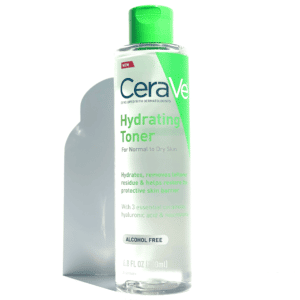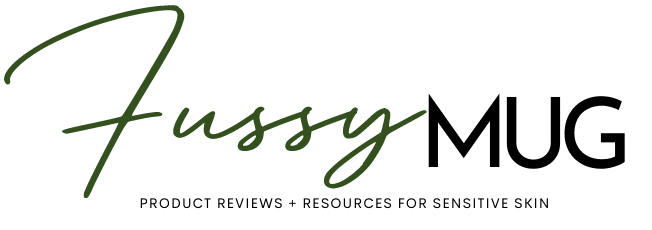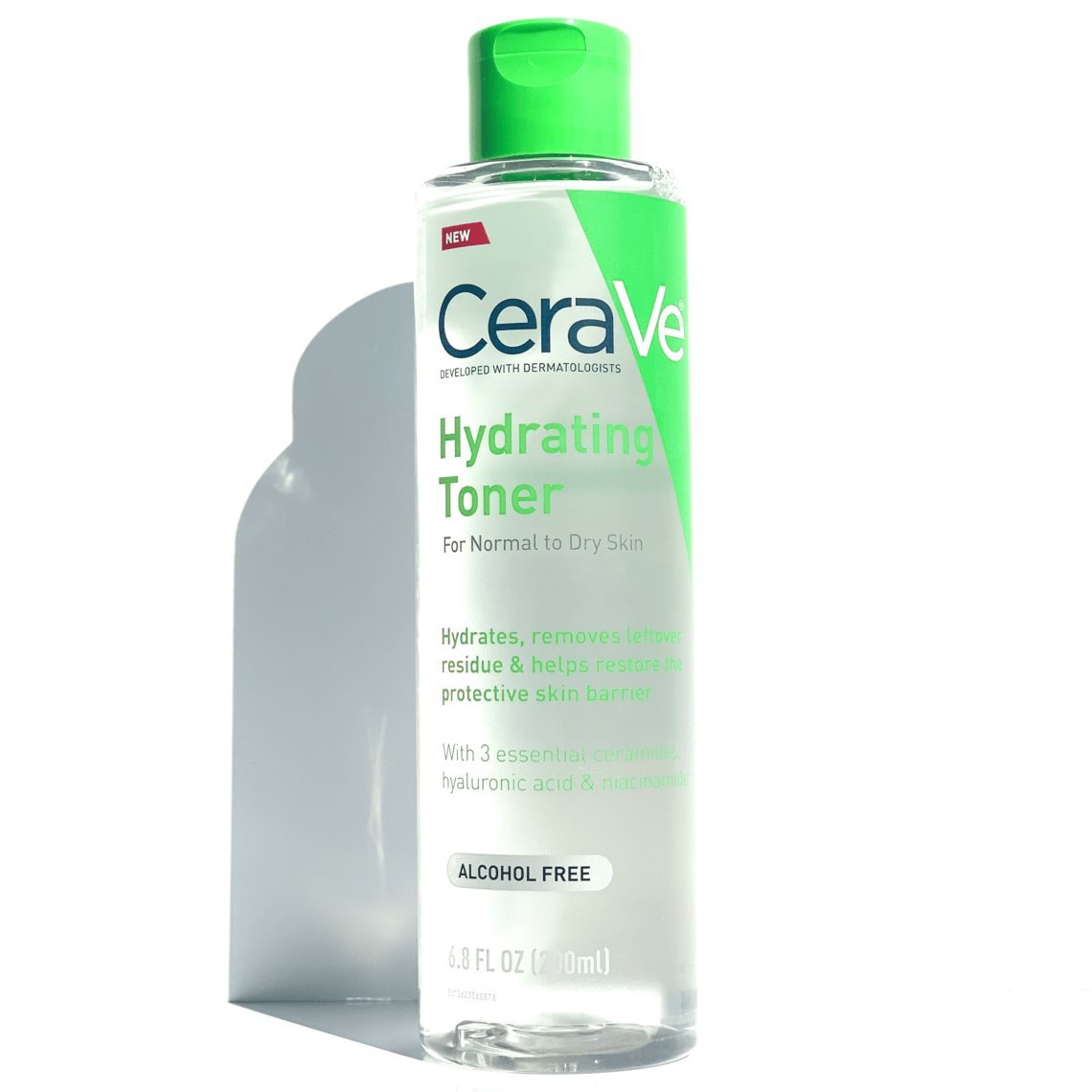CeraVe Hydrating Toner
Looking for a hydrating toner for combination skin? Meet your new best friend, CeraVe’s Hydrating Toner. It’s moisturizing, ph balanced and has all the bells and whistles to balance and hydrate combination skin types.
Product Profile
I have looked high and low for a moisturizing toner that doesn’t have all kinds of acne causing, moisture stripping ingredients in it. For many years I avoided these bottles of liquid hellfire due to all the unnecessary ingredients like alcohol, fragrance, and essential oils. As skincare evolved, more toner options became available. But unfortunately for me, most of the products I had tried just weren’t gentle enough for my skin. Thankfully, the idea of toners and the role they play have been reimagined and we now have products like moisturizing toners, hydrating toners, ampoules, and essences that are meant to moisturize and hydrate, not strip and sterilize.
Case in point with CeraVe Hydrating Toner. If someone were to ask me what my dream toner had in it, I would say, cholesterol for its ability to add moisture and support the skin barrier, ceramides which prevent TEWL (transepidermal water loss) and prevent dryness, and glycerine which hydrates and locks in moisture. It would be lightweight, moisturizing and obviously fragrance and alcohol-free and that’s exactly what this is. Is it perfect, no. But it’s really good which is why it’s the newest addition to my sensitive skincare routine.
Product Claims
According to CeraVe’s product page, CeraVe’s Hydrating Toner, is their “ first ever pH balanced and non-drying toner for the face.”
The toner is “developed with dermatologists”, and includes “ceramides, hyaluronic acid, and niacinamide, which helps restore the skin’s natural protective barrier for improved hydration, and helps visibly smooth and calm skin.”
“The formula is non-comedogenic, alcohol-free, oil-free, astringent-free, and fragrance-free and helps to remove leftover residue while helping maintain the skin’s moisture barrier.”
There are several skin supporting, barrier repairing ingredients in this toner. Like, glycerin, cholesterol, and three types of ceramides. Niacinamide can cause itching, burning, and flushing for some. Therefore I wouldn’t consider this a calming or recovery product to reduce irritation or decrease redness.
If you’ve read any of my previous articles. Then you already know that the “dermatologist developed” call out doesn’t mean much. It doesn’t make it safer or more gentle for sensitive skin. Oftentimes, the product in question has already been formulated and a dermatologist just reviews the ingredients. Or the derm provides a list of suggested ingredients that may or may not be included in the final product. Beyond that, there are plenty of ”dermatologist developed” products on the market that are terrible for sensitive skin. If there is no supporting evidence of clinical trials, or documentation on which doctors and how they contributed. The claim doesn’t mean much.
My Experience
I believe in a minimalist approach to skincare. Which for me means, I like my routine to be simple and the ingredient lists for the products that I use to be short. As a person with temperamental skin, I like to know and understand what exactly is in my products so I can identify what is helping and what isn’t working. I also have a routine that focuses on hydration, so I prioritize products with formulas that boost hydration rather than products that try and cram in every anti-aging active under the sun.
Unfortunately, finding products that meet this criteria is not easy. And I oftentimes have to make my own products to fill the gap. However, because I’m obsessed with skincare, I am always on the hunt for products to add to my arsenal. So when I find something I like, I like to have vetted products on hand that I can roll into rotation when needed.
CeraVe Hydrating Toner- A Hydrating Toner for Combination Skin
I came across this product several months ago during one of my favorite pastimes; walking the aisles of Target (pronounced Tar-jay). And was immediately excited to see that CeraVe had several new products.
I had been a long time user of CeraVe’s foaming facial cleanser. However, one day my skin decided that it didn’t like certain fatty alcohols and coconut derivatives. So I had to switch cleansers. At the time, I was using DHC’s Mild Lotion as a moisturizing toner, which I absolutely love! It is super gentle, hydrating and always helps heal my skin when my skin is in crisis mode. So, I wasn’t in the market for a new toner. However, I was intrigued by the ingredients so I made the purchase.
I tested CeraVe’s Hydrating Toner for about three months and I really loved it. It made my skin feel soft and dewy. There were times when I didn’t put my serum or moisturizer on immediately after applying the toner. And surprisingly, my face didn’t feel dry or tight. This toner added a nice hydration layer, making my skin feel fully prepped for the rest of my moisturizing routine.
Niacinamide + Hyaluronic Acid
After the three month trial period, I decided to keep the toner in rotation and patch test a new serum I kept hearing about on YouTube. Unfortunately, the serum did NOT work out. I broke out in hives during the patch test (more on that some other time). I resumed my prior routine (which included the Hydrating toner) and noticed that once I applied it, my skin started to burn.
My skin will react to niacinamide and sodium hyaluronate, if it is irritated enough. So I pulled back on the use of the toner until my skin was less angry. Once my skin recovered, I reintroduced the toner and had absolutely no issues. My suggestion is that if you are experiencing any active inflammation, you may want to hold off on trying this product until your inflammation has subsided.
How I Use It
After cleansing, apply several drops to a cotton pad or finger tips and apply all over the face and neck.
On warmer days I’ll apply a hyaluronic acid serum on top as my third step than finish with a lightweight, water based moisturizer.
On cooler or cold days, I’ll apply squalane oil as my third step then top with marula or argan oil.


PRODUCT SNAPSHOT
BEST FOR: Combination, dry or dehydrated skin types.
SENSITIVE SKIN FRIENDLY? Yes. However, do not apply to irritated, cracked, or inflamed skin.
CALMS IRRITATION?: No.
FRAGRANCE-FREE: Yes. But it does have a slight, non-offensive chemical smell.
POSSIBLE ALLERGENS: Corn, palm, coconut, soybean, petroleum, acrylic
PRICE: $8.99
CeraVe Hydrating Toner Ingredients

Aqua/Water, Propanediol, Glycerin, Butylene Glycol, Ppg-6-Decyltetradeceth-30, Peg-240/Hdi Copolymer Bis-Decyltetradeceth-20 Ether, Peg/Ppg/Polybutylene Glycol-8/5/3 Glycerin, Ceramide Np, Ceramide Ap, Potassium Laurate, Ceramide Eop, Carbomer, Niacinamide, Sodium Hydroxide, Sodium Citrate, Sodium Hyaluronate, Sodium Lauroyl Lactylate, Cholesterol, Phenoxyethanol, Chlorphenesin, Tocopherol, Citric Acid, Phytosphingosine, Xanthan Gum, Ethylhexylglycerin.
Water – Good ol’ plain H2O
Propanediol– A liquid solvent that acts as an emollient and occlusive. Propanediol can be naturally derived from corn or synthetically derived from petroleum. Those with corn or petroleum allergies should use with caution.
Glycerin – A sugar alcohol that can be derived from petroleum, corn, palm, rapeseed oil, or animal fats.
Butylene Glycol – An organic alcohol, often used as a humectant. Derived from corn, petroleum, or sugarcane.
Ppg-6-Decyltetradeceth-30 – An emulsifier and surfactant allowing liquids to evenly mix. Made from alkyl alcohol and ethylene oxide and/or propylene oxide.
Peg-240/Hdi Copolymer Bis-Decyltetradeceth-20 Ether – A viscosity controller made from butylene glycol.
Peg/Ppg/Polybutylene Glycol-8/5/3 Glycerin – A water-soluble, synthetic ingredient derived from glycerine. It’s a humectant, which helps attract water to the skin. It can be derived from petroleum, corn, palm, rapeseed oil, or animal fats.
Ceramide Np – This barrier repairing lipid is also known as Ceramide 3. It’s naturally found in the outer layers of the skin and is made from sphingosine. Sphingosine is made up of alcohol and amino acids. It can be harvested from plants or synthetically derived.
Ceramide Ap – Also know as Ceramide 6, this lipid helps moisturize and strengthen the skin barrier. Its made from a combination of fatty acids and sphingosines. It can be harvested from plants or synthetically derived.
Potassium Laurate – A potassium salt made from lauric acid. Used as an emulsifier and surfactant.
Ceramide Eop – Also referred to as Ceramide 9, this skin identical lipid is rich in fatty acids and linoleic acid. It keeps the skin hydrated and protects the skin from free radicals.
Carbomer – Made from acrylic acid, it is primary function is to turn liquids in to gel. Can cause contact dermatitis in those allergic to acrylic.
Niacinamide – A form of Vitamin B-3, also known as niacin. It can help to brighten the skin and improve acne. Also known to cause irritation and flushing for those with sensitive skin. It an be naturally derived from brewer’s yeast or synthetically derived from ammonia.
Sodium Hydroxide – Used to adjust a formulations pH. The chemical compound of lye. A well documented irritant.
Sodium Citrate – Commonly used to control the pH levels in a formulation. Derived from the salt of citric acid.
Sodium Hyaluronate – A salt form of hyaluronate acid, making it more stable and less likely to oxidize in products. Can exacerbate inflamed skin and cause further irritation if applied improperly.
Sodium Lauroyl Lactylate – An emulsifier made from lauric acid and lactic acid.
Cholesterol – A skin conditioning lipid that supports barrier repair and restores moisture. Can be derived from animals, wool, or plant sources.
Phenoxyethanol – A preservative made from petroleum. If you are allergic to petroleum or mineral oil, you may have sensitivity to Phenoxyethanol.
Chlorphenesin – A synthetic preservative derived from chlorine.
Tocopherol – A skin conditioning, antioxidant that can be derived from the oil and fats of vegetables, nuts, seeds and some dairy products.
Citric Acid – Derived from citrus fruits. Added to formulations to balance pH. May cause further irritation in those experiencing active inflammation.
Phytosphingosine – A barrier repairing and protecting fatty alcohol that restores hydration and helps promote collagen production. It can be derived from plants, animals, or yeast.
Xanthan Gum – A fermented sugar used to thicken a formulation. It can be derived from corn, soy, dairy or wheat.
Ethylhexylglycerin – A vegetable glycerine commonly derived from palm, coconut or soybean oil.
Smell, Texture + Consistency
- It’s fragrance-free, but not free of fragrance. It has a slight, non-offensive chemical smell.
- It goes on like a toner, but has a smooth finish with a bit of slip. Slightly oil-like, but not oily.
- It has a typical toner-like watery consistency. Dries to a satin finish. But not drying.
Alternatives
DHC Mild Lotion
If CeraVe’s Hydrating toner doesn’t work for you. And you’re still in the market for a hydrating toner for combination skin. DHC’s Mild Lotion is a great alternative. Although they call it a lotion (it’s not). It has a watery, toner-like consistency and you apply it just like you would a toner. Its gentle, hydrating and balances oily skin while hydrating dry skin. And the best part is, it only has eight ingredients. It’s one of the only toners I can use when my skin is inflamed as it helps to calm things down without causing irritation. Check it out here.
Is It Sensitive Skin Friendly?
- Yes. However, I would not consider this a soothing or calming product. I recommend using this product only when your skin is not actively irritated.
- It’s a great hydrating toner for combination skin it’s hydrating and balancing.
- If you are experiencing irritated, cracked or inflamed skin. You should skip this until your skin is feeling its best.
CeraVe Hydrating Toner – Final Thoughts
Who They Say It’s For?
- All skin types.
Who Is It Really For?
- It’s a great hydrating toner for combination skin.
- Dry and dehydrated skin types will also appreciate its ability to hydrate and soften.
- Oily skin types should also give this a try as it could help with balancing the skin.
- If you have extremely oily skin. You may be able to get away with using this and a light-weight serum or gel moisturizer.
Who Is It Not For?
- Ingredients like niacinamide, sodium hyaluronate, and citric acid (all ingredients in this toner) can trigger further irritation in even the smallest amounts. Those that are experiencing active inflammation, irritation, cracked or broken skin. As previously mentioned, I recommend using this product only when your skin is not actively irritated.
What I Like About It
- Its inclusion of glycerin, ceramides, and cholesterol make this a great hydrating toner.
What I Don’t Like About It
- This is another formulation that could use an edit. Ingredients like sodium hyaluronate and niacinamide aren’t really necessary, given some of the other hydrating and reparative ingredients already in it. Both can cause inflammation, making it a less than desirable product for those looking to calm irritated skin.
If you’re looking for a hydrating toner for combination skin, I would definitely give this one a try. It is by far one of the best CeraVe productss I have tired and it doesn’t break the bank. Do you have a favorite hydrating toner sensitive skin? Let me know in the comments below.
LATEST POSTS
Histamine Intolerance Foods To Avoid
Histamine Intolerance Foods To Avoid Wondering which histamine intolerance foods to avoid? In my…
May 22, 2023Low Histamine Diet Food List
Looking for a comprehensive low histamine diet food list? Well if you’re like me…
March 24, 2023What Causes Histamine Intolerance?
What causes histamine intolerance can be a tricky question. It can be difficult to…
March 17, 2023




No Comments